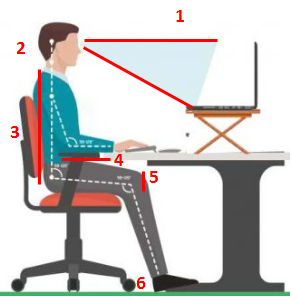Working from home can have some challenges, but there are things you can do to minimise risks and improve your comfort and productivity.
Please make sure that your home workspace meets legal requirements
Organising your workspace
You should try to have your workspace set-up at home similar to your set-up at work, so that it's comfortable and user-friendly.
Setting up your work desk correctly will help you to have good posture. This reduces musculoskeletal disorders, including upper limb disorders and repetitive strain injuries.
See: Working from home
Improving your workspace
Even though many people are working from home unexpectedly because of the coronavirus outbreak, we must make sure that your workspace meets legal requirements. You should complete the DSE General Awareness Module on HSeLanD and with your manager complete an assessment of your workstation
Position your screen correctly
Reduce eyestrain by positioning your screen at arm's length from your face and at the correct height to allow a comfortable neck position. You should aim to have your eyes roughly level with the top of your screen.
Avoid glare
To reduce eyestrain, you should avoid having a glare on your screen. It's best to position your screen away from direct window light and close curtains when necessary.
Keyboard
Having awkward wrist, arm and shoulder positions may lead to discomfort and injury. Adjust the height of your keyboard so that your wrists are in line with your forearms.
Change positions
Change your position from sitting to standing regularly to avoid awkward, static postures.
Give your eyes a break
To allow your eye muscles to rest, focus on an object 20 feet away every 20 minutes for 20 seconds.
Chair
Adjust your chair so your feet are flat on the floor, without uncomfortable pressure on your thighs. You can use a foot rest. Your lower back should be fully supported by the lumbar support in your chair. Ideally, you should have an office chair, otherwise you could use a cushion for lumbar support.
Get up and move
Break up long spells of screen work with rest breaks or changes in activity (for at least 5 minutes every hour).
Regular stretching
These stretches should be done slowly. If you feel any discomfort or pain, do not push beyond the intended stretch.
Here are some simple examples of muscle stretches that you can do at home
Improve your laptop set-up (laptop stand, keyboard and mouse)
Laptops are not intended for long term use as a workstation. If you are using it a lot at home then your workstation should meet the principles of workstation set-up, with a separate mouse, screen and keyboard.
Viewing angle, head and neck position
Use a laptop stand as it helps your head to stay up, straightening your neck, shoulders and back. If you do not have a laptop stand, try using books to improve your viewing angle.
Back position and support
You should use a purpose designed office chair where possible. If you're using a kitchen chair then use a cushion to support a more upright posture.
Forearm and wrist position
Your hand, wrist and forearm should form a level line from your keyboard to your elbow. Your wrist should not be bent and should float above your keyboard.
Move your mouse through a combination of elbow and shoulder movements - your wrist should not be involved.
You can use cushions to elevate your seating position, helping to keep your forearm, wrist and hand level.
Leg and foot position
You should use a footrest to ensure your thighs remain almost parallel to the floor, with your hips slightly higher than your knees. Keep space between the back of your knees and the edge of the chair. If you do not have a footrest, you can use a plastic box.

legal requirements still apply. You should complete the DSE General Awareness Module on HSeLanD and with your manager complete an assessment of your workstation
Advice for managers
As a manager, you have responsibility for the health and safety of your employees.
These responsibilities include:
- managing work activities to ensure, as far as reasonably practicable, the safety, health and welfare of your employees
- providing safe systems of work that are planned and maintained, assessing risks and implementing appropriate control measures
- providing information, instruction, training and supervision regarding safety and health
- having plans in place for emergencies
Related topics
Information on Display Screen Equipment from the Health and Safety Authority